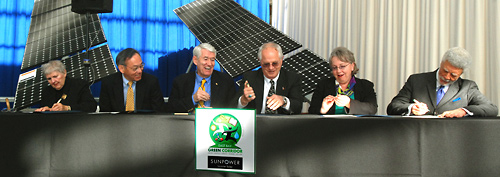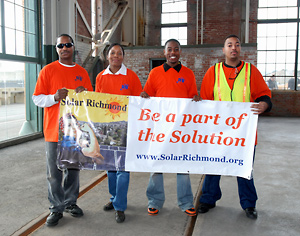Berkeleyan
 Monday saw four local mayors join with the chief executives of the Berkeley campus and Lawrence Berkeley National Laboratory to sign a statement of principles launching the East Bay Green Corridor initiative. From left: Emeryville Mayor Nora Davis, LBNL Director Steve Chu, UC Berkeley Chancellor Robert Birgeneau, Berkeley Mayor Tom Bates, Richmond Mayor Gayle McLaughlin, and Oakland Mayor Ron Dellums. (Peg Skorpinski photo) |
East Bay cities, campus, and LBNL announce 'green corridor' ambitions
Berkeley, Lawrence Lab, and four municipalities envision the region's future as a hub of environmental research and industry
![]()
| 06 December 2007
From a new solar-energy facility on the Richmond waterfront where workers once assembled Ford autos, the leaders of UC Berkeley, four local cities, and Lawrence Berkeley National Lab announced on Monday a collaborative effort to turn San Francisco Bay's east shore into an engine of a 21st-century "green" economy.
The mayors of Berkeley, Oakland, Richmond, and Emeryville joined forces with Berkeley Chancellor Robert Birgeneau and LBNL director Steve Chu in the Dec. 3 launch of the East Bay Green Corridor Partnership (EBGCP) - aimed at "establishing our region as one of the world's leading centers" of environmental innovation, alternative-energy research, and green business and industry, Birgeneau said.
"Our region has a long and distinguished history in environmental awareness, conservation success, and policy innovation," reads a Statement of Principles signed by the six leaders. ". Each of our entities is committed to bringing our unique strengths to the table and building the heart of the East Bay into a dynamic 'Green Corridor.'"
For Richmond Mayor Gayle McLaughlin, what that means concretely is collaboration to secure federal funds for green-collar jobs and workforce-development training for marginalized young people. By asking "for the same thing as a unified group," East Bay cities will have a greater chance of success, she predicted.
Materials-science engineer Ilan Gur of the Berkeley-based energy-storage start-up Seeo, Inc., spoke of the role of Berkeley (his alma mater) and Berkeley Lab in producing technological breakthroughs for the local and national green economy, as did Chu and Birgeneau.
'Putting aside chauvinism'
The press conference took place at SunPower Corporation's new facility in Richmond, a city that hopes to become, in its mayor's words, "the first green industrial city in the U.S., setting policy that provides incentives for green business, manufacturing, renewable energy, and environmental justice." The dual challenges of global warming and urban poverty, McLaughlin said, require "nothing less than a historic reinvestment in our young people and our inner cities.. To put meaningful numbers of people to work, we will need massive funding."
According to Berkeley Mayor Tom Bates, the green-corridor partnership sprang from a dinner at University House initiated by Chancellor Birgeneau. That exchange between local mayors, he said, led to putting aside "our cities' chauvinism" in the belief that together they can be stronger than "the sum of the parts..We want to make the East Bay the Silicon Valley of the green economy."
The city of Berkeley alone is home to 87 "green" businesses, Bates noted, and the East Bay to more than 200 such enterprises. Through a "regional green-job training program" involving educational institutions at all levels, from local high schools to UC Berkeley, "we're going to catch that green wave, and everybody's going to be on that boat," he asserted.
Oakland Mayor Ron Dellums noted that the United Nations had just convened, in Bali, an international conference on climate change, hoping to achieve a climate-protection accord. "Simultaneously we're coming together locally" to accept "the challenge and opportunity of global warming," he said.
The "opportunity" side of that equation - for cities like Oakland plagued by what Dellums called "the unfinished business of America, the outward manifestation of 40 years of neglect" - is the chance to train marginalized communities for emerging jobs with some of the monies set loose to address environmental issues. (A recent study by the national Apollo Alliance concluded that major national investment in energy efficiency, renewable energy, and renewable fuels could result in the creation of nearly 3.5 million U.S. jobs.)
 Through a collaboration between the city of Richmond and the nonprofit organization SolarRichmond, these workers gained skills in construction and solar-panel installation. (Peg Skorpinski photo) |
Dellums referred to nearly a quarter- million dollars recently earmarked by the Oakland City Council for a Green Jobs Corps, whose mission would be to train workers in such areas as biofuels manufacturing and solar-panel installation. McLaughlin cited a workforce-development effort in Richmond that is incorporating solar technology into the city's nine-week construction-trade pre-apprenticeship program.
On hand, bringing lofty rhetoric down to Earth, was a lively contingent of trainees from the Richmond BUILD-Solar Richmond collaboration. "Three weeks ago you couldn't have told me I would be on someone's roof installing solar panels - doing connections, bending conduit, running wire," said Angela Greene. "But now that it's been introduced to us, it's an experience I'll never forget and a second career for me that I'm looking forward to..
"For me this is the new dotcom," she said of solar technology. "I missed out on that opportunity, but I will not miss out on this one." Greene said she and her colleagues secured jobs in the solar industry within weeks of completing the training program. "We're talking it and we're walking it. Here we are!"
Green-collar jobs in focus
These workers' enthusiasm about a shot at a viable career and the chance "to help out" in solving global warming - as one formerly unemployed worker put it - corroborates the findings of a forthcoming study on Bay Area green-collar jobs conducted by Raquel Rivera Pinderhughes. In a Nov. 29 campus talk the San Francisco State urban-studies professor defined green-collar jobs as manual-labor jobs that directly improve environmental quality, noting that more than 20 sectors of the U.S. economy offer such jobs, ranging from solar-panel installation to home weatherization, the organic foods industry, and recycling.
Pinderhughes surveyed the 80-plus green businesses in Berkeley, as well as unemployed Bay Area workers, to get a read on whether and how such jobs could benefit both the environment and marginalized communities. Those with barriers to employment are "very interested" in green-collar jobs and the "environmental-improvement aspect of this work," she found. "They come from communities that have been disproportionately burdened by negative environmental impacts; they understand the importance of improving local environmental conditions, and they're attracted to the idea of being part of that work."
For a number of reasons - including private investment in green industry, policies to improve urban environmental quality and reduce greenhouse gases, and "efforts of large institutions like UC Berkeley to reduce their environmental footprint" - the green economy in the Bay Area "is poised to expand significantly," she found, "and as it expands there're going to be huge increases in workforce opportunities."
Pinderhughes is collaborating with the Oakland-based Ella Baker Center for Human Rights to create a training curriculum for that city's nascent Green Jobs Corps. The non-profit's Ian Kim called green-collar jobs "an eco-populist way to open up a conversation" on the environment.
"If we go to low-income neighborhoods in West or East Oakland and start a conversation about polar bears . it's hard work. But if we start by talking about Hurricane Katrina" as a climate disaster or about "impacts of environmental racism" such as high incidences of asthma epidemics or cancer, "then we don't have to finish our sentences," he said. "People who are looking for work and are under-employed get this idea of green-collar jobs. It's not a leap."
A caveat tendered by Pinderhughes - one that movers and shakers of the East Bay Green Corridor will no doubt contend with as they work to fulfill their pledge - is green businesses' need for affordable properties. "I cannot emphasize how critical and important it is to preserve industrially zoned, affordable land" for green enterprise, she said.
The Green Corridor agreement will create a variety of incentives for green businesses to locate in the East Bay. The signatories also agreed to hold an annual green-economic summit; convene quarterly meetings between their economic-development, workforce- development, and technology-transfer offices; and coordinate a regional green-job training and placement effort.
Visit www.ci.berkeley.ca.us/mayor/docs/EBGC.pdf for information on the EBGC Partnership. Pinderhughes' report on Bay Area green-collar jobs will be posted shortly on the website of the Ella Baker Center for Human Rights, ellabakercenter.org.

